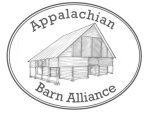The Mars Hill township is large and sprawling and, on first glance, it may appear to be less rural than the more remote and mountainous townships in Madison county. Its proximity to Asheville and larger highways has also given it a more modern feel, and many of its barns appear newer and more actively used. A closer look, however, will reveal some of the oldest and most interesting barns in Madison County. All these historic barns quietly embody the stories of farm families who have lived here over the past two centuries. The detailed histories of the older barns are rarely known however, as there are few family descendants remaining to tell their stories.
Our mountain region did not become formally open to white settlement until 1792, and homesteads of the day included a type of barn that remained unchanged for eighty years: the Appalachian log livestock barn. It had log crib enclosures for animal stalls on the ground level, and a large hay loft on the upper level, also used for threshing grain. The Jim Phillips barn is a good example. Most Appalachian livestock barns were also “bank barns” with an embankment to access the upper loft level, represented by the John Wesley Roberts barn and the William Washington White barn. It was not until 1870 that a new type of barn was introduced to the mountain region: the flue-cured tobacco barn, a specialized log barn built to heat-cure Bright Leaf tobacco. The Mars Hill township has several good examples of this old barn type. Unfortunately, they are not visible from a road.
The introduction of the new burley tobacco variety around 1918 replaced the flue-cured Bright Leaf tobacco era and brought a major change in the function and design of local barns. Prior to this time, all barns were either general purpose livestock barns, or the small flue-cured log barns. Burley tobacco was air-cured and required the flue-cured tobacco barns to be adapted to burley tobacco by the removal of the mud chinking to allow for better air flow. Thus, these became the first generation of burley tobacco barns. As the burley tobacco market grew, the livestock barns, with their well-ventilated hay lofts with lattice siding, were retrofitted with horizontal tier poles to allow the hanging and air-curing of the burley tobacco.
As in all mountain townships, barn builders made appropriate use of the abundant chestnut trees, the wood of which was resistant to bugs and rot. The chestnut blight, which made its way into Madison County in the 1920’s, eventually killed all the chestnut trees. The log scars left from the blight fungus serve as a way to determine the age of a log barn: if chestnut logs do not have blight scars, the barn was likely built before 1920.
The next major change in barn design began around 1915 when metal roofing became available, and the gambrel barn roof appeared. The Jeter Robinson main barn is an example of a gambrel roof. Prior to the introduction of metal roofing, the roofs of all farm buildings were covered in split oak shingles, and were very steep to shed water and snow quickly. The upper section of the new gambrel roof has a shallow pitch, requiring the use of metal roofing. Metal roofing also allowed builders to continue building the gable or “A” roof, yet with a lower roof pitch, as in the Jeter Robinson burley barn, and the Joseph Bascomb Huff barn.
Another new and distinctive barn type in this township is the monitor roof barn. While found in other areas, the Mars Hill township has many of this type. The Samuel Moore barn is one of the earliest, from the 1930’s, built exclusively for air-curing burley tobacco barn. The Woods Ammons barns are good examples of monitor roof barns that became popular after WWII. Like the gambrel roof, the monitor roof barn was an “imported” design and was introduced to improve ventilation for the air-curing process.
Jacob Bascomb Huff Barn MDmh0001
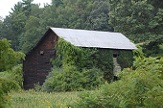
136 Hickory Drive
Mars Hill, NC 28754
This historic farm is in the rolling hills on the edge of Mars Hill, next to residential areas and the Mars Hill University campus. The farm has been in the ownership of the Carter and Huff family for six generations. Edward Carter donated the four acres on which Mars Hill College was founded in 1856. Ownership originated in a deed from his father Daniel, in 1815, for land totaling over 660 acres. Many Huff family members held leadership roles in the college. Family oral tradition includes a common story about a mountain lion, or panther, Read more
John Wesley Roberts Barn MDmh0002

548 Bend of Ivy Road
Mars Hill, NC 28754
This farm represents good examples of many of the out-buildings and barns that were integral to successful farming in Madison County up to the present time. Surviving outbuildings include a log woodshed, corncrib, casing house and granary, broiler chicken house, hog shed, two flue-cured tobacco barns, equipment shed, and springhouse. The centerpiece is a large, log crib livestock barn typical of the late 1800s. It is a bank barn built into the hillside, allowing access to the second-floor loft level. Read More
Curtis Buckner Barn MDmh0003
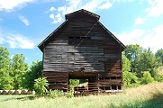
John Allen Road
Mars Hill, NC 28754
The Curtis Buckner burley tobacco barn is on the original Tommy Allen farm, passed down to his daughter Sarah Allen, who married Curtis Buckner. The farm was part of an early speculative development on Gabriel’s Creek, by Gabriel Keith and John Allen in the 1830’s. Burley tobacco was relatively new in the mountains and was typically air-cured in adapted log barns or livestock barn hay lofts. This innovative monitor roof barn was one of the earliest barns built exclusively for air-curing burley tobacco Read More
Riddle Honeycutt Barn MDmh0004
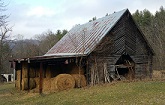
278 Riddle Hill Road
Mars Hill, NC 28754
This barn is part of a farm the history of which is mostly lost. It sits in a pastoral setting on the outskirts of Mars Hill on Riddle Hill Road. The large turn-of-the-century house was a modern design for its period, and is accompanied by a large garage and utility building, chicken house, wood shed, and spring house. The barn is a fully wood-framed structure, and is a transitional form that evolved from the typical log crib tradition of the period. It retains the traditional lattice work on the loft level Read More
Jacob Carson Tilson Barn MDmh0005

1541 Silvers Mill Road
Mars Hill, NC 28754
This barn consists of a central log section built of large, slightly hewn, round logs. The center section dimensions of 18 feet by 22 feet, and 18 feet high, indicate that it could have originally been built as a flue-cured tobacco barn, yet there is no evidence of mud chinking between the logs, or that it was ever used to heat cure tobacco. The shed roof additions on all four sides appear to have been built early in the existence of the central log section. There are no log crib animal stalls, Read More
Jervis Ray Barn MDmh0006
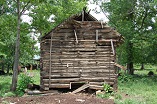
92 Parkway View Road
Mars Hill, NC 28754
The history of this rare 19th century barn is unknown, but detailed deed searches reveal that an early owner of this farm, John “Rezi” Jervis, was listed as a farmer in the 1850 census. He died in 1874, around the time that flue-cured tobacco was introduced to Madison County. If not built by Rezi Jervis, the barn was likely built by one or more of his sons, William, James, or J.M. The farm is part of an original landholding of 120 acres at the upper end of Parkway View Road, previously known as Jarvis Road, Read More
Jeter Robinson Barn MDmh0007
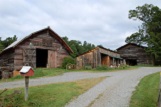
7174 NC Highway 213
Mars Hill, NC 28754
Jeter Pritchard Robinson was born in 1892 of a large, influential family in the Mars Hill area. He was named after Jeter Conley Pritchard, a well-known late 19th century US Senator and judge from Madison County.
This farmstead has good examples of several barns and outbuildings still in use today. The main gambrel roof livestock barn was built in 1933. It is a bank barn that allows trucks and tractors to drive into the loft level. The loft floor was also used for threshing wheat until the 1950’s. Like most barns of this period Read More
James Phillips Barn MDmh0008
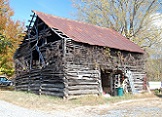
418 Stone Cottage Road
Mars Hill, NC 28754
This log crib livestock barn is a classic nineteenth century Appalachian barn that pre-dates the era of tobacco in the mountains. Its classic features include hewn log animal stalls with lattice siding on the upper hay loft level. Two of the surviving stall doors have the original hand-made wood hinges. As was common with most early livestock barns, the hay loft was later adapted to air-cure burley tobacco. The farmstead was built by James L. Phillips in the late 1800s; the builder of the house was paid $1 a day for 180 days, plus a mule. Read More
Samuel Moore Barn MDmh0009
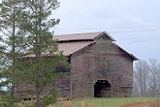
300 Hazel Brook Road
Mars Hill, NC 28754
The Samuel Moore burley tobacco barn is known by family members to be the earliest monitor roof barn in eastern Madison County. It was built exclusively for air-curing burley tobacco, and was an innovative design for its day. The barn accommodates seven tier pole levels within its great height, for hanging tobacco, and is said to hold three acres of tobacco. The rock piers supporting the pole-frame walls were set by the builder according to the signs of Zodiac and moon phase so that they would not heave during freezing weather. Read More
Tommy Allen Barns MDmh0010
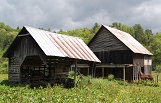
437 John Allen Lane
Mars Hill, NC 28754
Thomas Allen likely built his house in the 1880’s; the barn appears to have been built later, perhaps in the early 1900’s. It would have replaced a log crib barn. This barn represents the transition from log crib livestock barns to fully wood-framed barns. It retains the classic features of lattice siding on the hay loft level, for good ventilation, and the lapped wood siding in the gable ends. A shed roof addition was later added for burley tobacco, and a deck structure for loading hay and shelter. The farm also includes many outbuildings: a springhouse, sorghum cane cooker, corn crib, can house, carriage house, and other barns. Read More
Woods Ammons
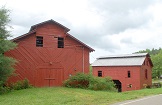
1889 Lower Gabriel’s Creek Road
Mars Hill, NC 28754
These barns are situated at the lower end of the valley of Gabriel’s Creek on what was once part of a much larger farm. They were built at the close of WWII when many men were returning from the war and the burley tobacco market was growing. Woods Ammons was one of the largest growers of burley tobacco in eastern Madison County and was known for his use of up-to-date farming practices, including better ventilation by way of the monitor roof and window vent shutters. His two monitor roof barns were well COMPLETE INFORMATION BARN #1 and COMPLETE INFORMATION BARN #2
W.W. White Barn MDmh0013
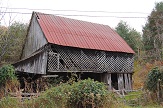
3172 Windswept Ridge Road
Mars Hill, NC 28754
The William Washington White log crib livestock barn is another classic Appalachian bank barn, likely built in the late 1800s. It is a roughly built barn, surprising since White was a prominent landowner and county leader. The family home across the road, however, is an example of a well-built two-story house of the period, with interesting vernacular carpentry details. The barn also had an attached corn crib, while the canning house and spring house were conveniently located next to the main house. White served in both the Union and the Confederate Read More
